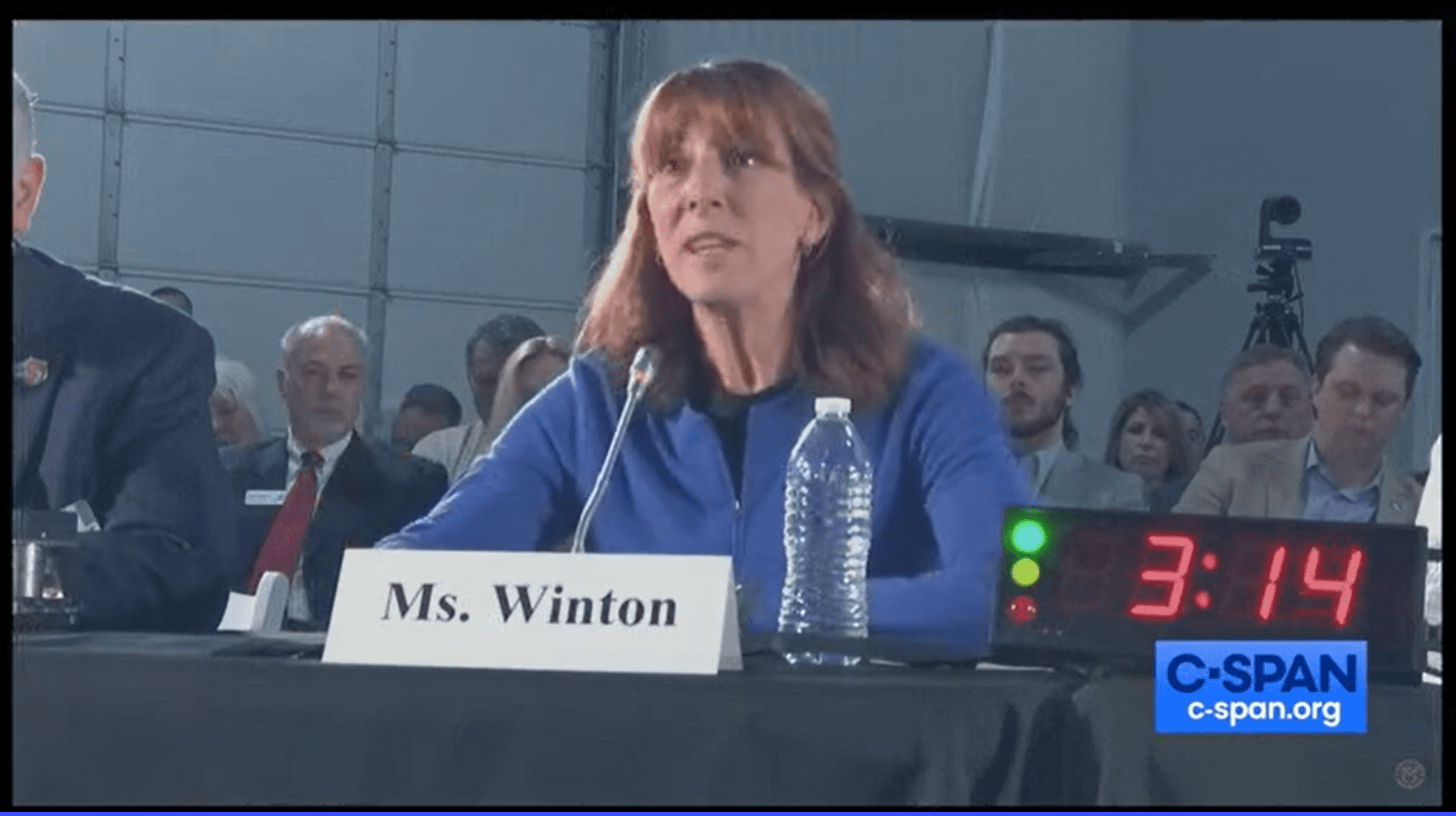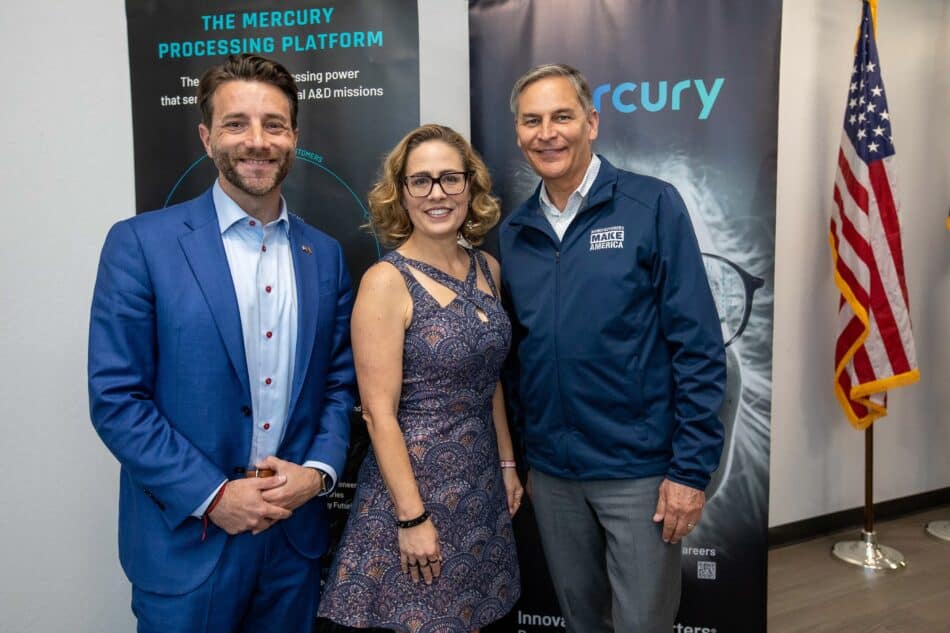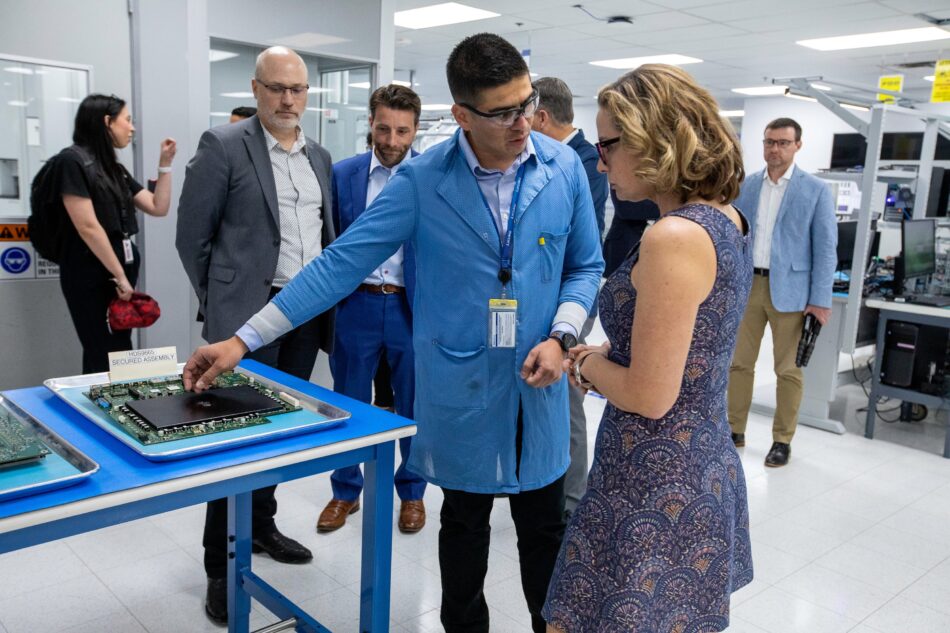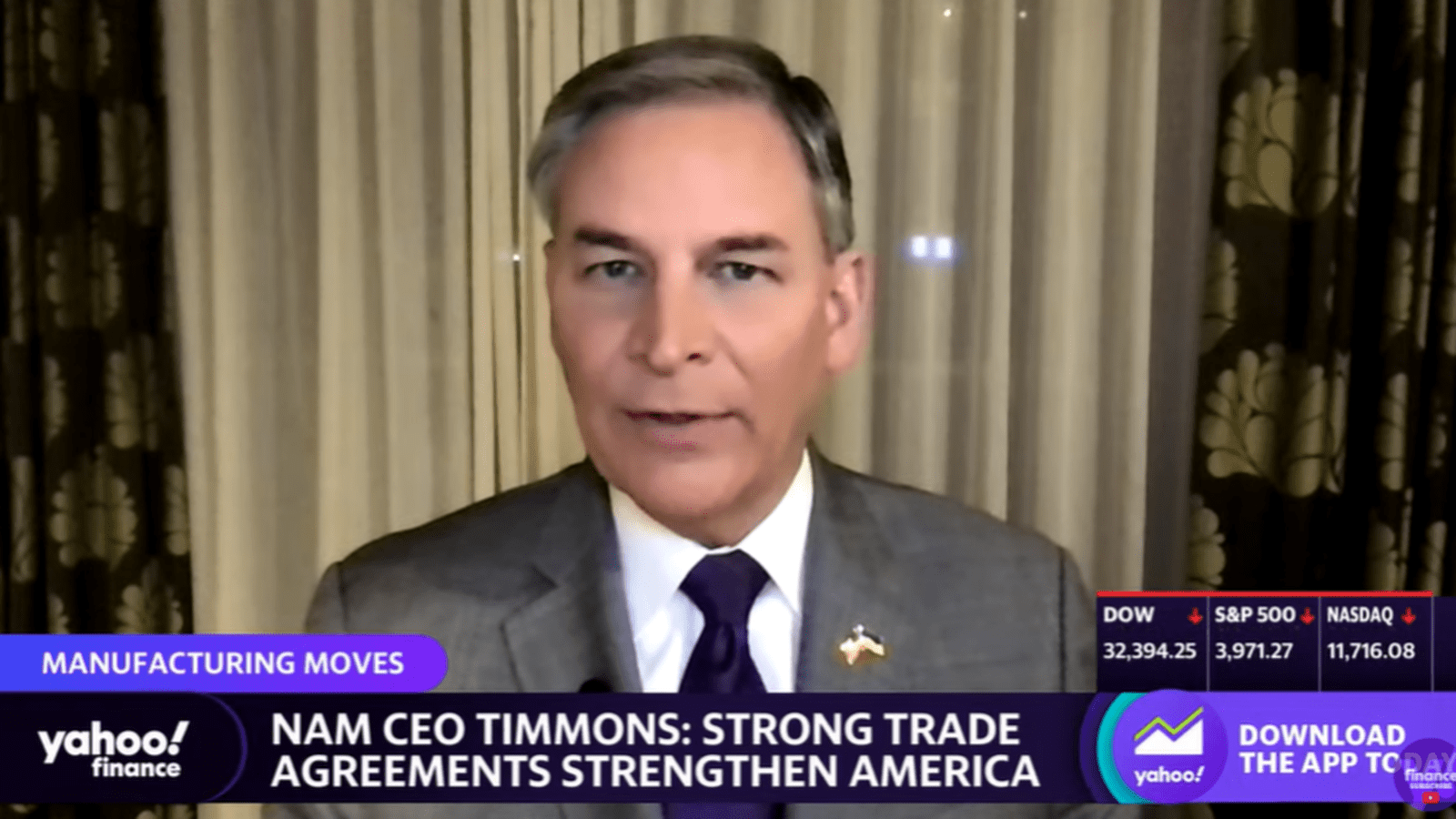Winton Machine CEO: Changes “Are Like a Tax on Manufacturing Growth”

Recent changes to the U.S. tax code are threatening manufacturers’ continued success—and they need to be reversed now, Winton Machine Company CEO and NAM board member Lisa Winton told U.S. lawmakers at a recent hearing.
What’s going on: Winton, whose 25-year-old company designs and manufactures machines used in tubular part and coaxial cable fabrication, testified before the House Ways and Means Committee at a hearing last Friday on the state of the American economy.
- Winton spoke about the challenges facing manufacturers and highlighted the impact of two recent changes to the tax code that increase the cost of financing machinery purchases: the phaseout of immediate expensing and limitations on deductions for interest on business loans.
- “While I would like to double the size of my facility, the cost of doing so has risen fourfold over the last several years,” said Winton, whose business is one of approximately 244,000 small manufacturers in the U.S.
Why it’s important: “These changes are like a tax on manufacturing growth,” Winton said.
- Winton expressed concern that “these changes will force our customers to keep using older pieces of equipment, rather than purchasing newer or additional ones, or they will buy cheaper equipment from Asia.”
- In addition to these two harmful changes, Winton spoke about another recent revision requiring businesses to deduct or amortize their R&D expenses over a period of years. This makes R&D more expensive because businesses “can [now] only recover a small portion of those costs each year.”
- In sharp contrast to this treatment, China currently allows a “super deduction” for manufacturers, Winton noted.
More to come: There are more harmful changes on the way. The 20% pass-through deduction is set to expire in 2025, “at the same time that tax rates for pass-through entities like ours go up across the board,” Winton said.
- In addition, a scheduled change to the estate tax could force family-owned businesses to sell off pieces of their companies.
The last word: “None of these tax changes are fair to our employees, their families [or] our communities,” she said. “We need to fix them so we’re not making it harder to do business in America.”
NAM, Arizona Chamber Host Sinema for Immigration Panel

Immigration reform is an economic necessity—and it needs to happen now in order to spur economic growth and keep manufacturing in the U.S. competitive, NAM President and CEO Jay Timmons told an audience at a recent roundtable in Phoenix featuring Sen. Kyrsten Sinema (I-AZ).
- “Manufacturers want to build consensus,” Timmons said. “Most Americans agree that our immigration system is broken. And we need to fix it, whether it’s major legislation or targeted, specific fixes.”
What went on: The NAM and the Arizona Chamber of Commerce & Industry hosted Sinema last Friday for a discussion on fixing immigration policy and other matters critical to manufacturers.
- A seven-person panel—which included Valley Forge & Bolt CEO Michele Clarke and Intel Corporation State Government Relations Senior Director Jason Bagley—talked about the current challenges facing manufacturers and the urgent need for solutions on immigration, workforce development, tax policy and more.
- Held at the Phoenix facilities of defense-electronics company Mercury Systems, the roundtable was part of the NAM’s Competing to Win Tour, a facility-visit and discussion circuit that began in February. Its aim: to bolster manufacturing competitiveness through conversations between manufacturers, political and community leaders, employees and the media.
What needs fixing: “As I travel across Arizona, I hear from employers of all sizes about the challenges they face filling jobs,” Sinema told the audience of manufacturers and industry stakeholders. “This is especially true in the manufacturing sector. That is why I’ve been hard at work identifying realistic solutions.”
- Indeed, the workforce “problem isn’t going away,” added Timmons, who moderated the event. “We have nearly 700,000 open jobs right now. And 4 million manufacturing jobs will need to be filled by the end of the decade, 2.1 million of which could go unfilled if more people are not brought into the industry … according to research from Deloitte and the Manufacturing Institute, the NAM’s workforce development and education partner.”
How to fix it: Part of the solution is right in front of us, Timmons said.
- “There are many policy fixes that could build our pipeline of skilled employees—people who can excel in manufacturing positions while contributing to our society and building lives for themselves in America.”
- He referenced “A Way Forward,” the NAM’s policy blueprint featuring implementable action items for legislators on immigration reform and related issues, such as the undocumented population and green-card backlog.
NAM on the air: Timmons and Arizona Chamber CEO Danny Seiden were guests on Phoenix radio station KTAR News’ “Mike Broomhead Show” to discuss the Competing to Win tour and the importance of manufacturing jobs.
NAM Joins Arizona Business Leaders to Discuss Immigration Reform with Sen. Kyrsten Sinema
Phoenix, AZ – National Association of Manufacturers President and CEO Jay Timmons and the Arizona Chamber of Commerce & Industry President and CEO Danny Seiden jointly hosted Sen. Kyrsten Sinema (I-AZ) for a discussion with members of the Arizona Manufacturers Council and other local business leaders today at Mercury Systems in Phoenix, Arizona. The conversation focused on the manufacturing workforce and how immigration reform is urgently needed to strengthen it.


“The majority of Americans agree that the United States has a broken and unreliable immigration system, and our industry is united in the belief that this broken system is harming manufacturers’ competitiveness. With nearly 700,000 open jobs in manufacturing today and millions to fill this decade, immigration must be part of the solution,” said Timmons. “We must stay true to the values that have made America exceptional and kept manufacturing strong: free enterprise, competitiveness, individual liberty and equal opportunity, and that requires a functioning immigration system that addresses our economy’s needs, as well as security and humanitarian concerns. Today’s discussion is an important step in the path toward building consensus for advancing immigration reforms, and we thank the Arizona Chamber of Commerce & Industry and Sen. Sinema for their leadership.”
“Arizona has emerged as a premier destination for manufacturing growth, thanks to the pro-business policies we’ve implemented on a state level that have cut regulations and created an attractive tax environment for job creators to locate and expand,” said Chamber President and CEO Danny Seiden. “Of course, there is so much to be done at the federal level to ensure the continued competitiveness and success of our state and nation’s manufacturing industry – and immigration and workforce must be a part of the discussion. We are grateful for the partnership and leadership of Sen. Sinema and NAM in addressing this critical issue.”
“Mercury was delighted to host Sen. Sinema and global technology manufacturing leaders for this important conversation,” said Tom Smelker, Mercury Systems’ vice president and general manager of microsystems. “The vast majority of advanced semiconductor packaging is done in southeast Asia today, and the United States recognizes the need for more secure domestic capacity. But our skilled labor workforce is constrained, and we need a faster path to bring in more talent.”
Background: The NAM’s immigration policy recommendations are outlined in “A Way Forward,” a plan originally released in 2019 and recently updated to reflect current challenges. The NAM’s “A Way Forward” proposal identifies seven core areas of action for Congress and the administration to take:
- Strengthen border security through physical infrastructure and best-in-class technology.
- Prioritize America’s workforce needs through reforms to the legal immigration system.
- Reform nonimmigrant visas and temporary worker programs to reflect employer needs, including a fund to support STEM programs so that we can reduce the need for these types of visas in the future.
- Provide a permanent and compassionate solution for populations facing uncertainty, including the Dreamers, who were brought here as children and know no other home.
- Reform asylum and refugee programs for a more orderly and humane system, including asylum standards consistent with our values.
- Fix the problem of the unauthorized population with a firm reset, requiring an orderly process of review, including financial penalties for those who seek to become legal and deportation for those who choose to stay in the shadows.
- Strengthen the rule of law, with a focus on gang violence and on requiring localities to cooperate to advance the enforcement of immigration priorities.
-NAM-
The National Association of Manufacturers is the largest manufacturing association in the United States, representing small and large manufacturers in every industrial sector and in all 50 states. Manufacturing employs nearly 13 million men and women, contributes $2.90 trillion to the U.S. economy annually and accounts for 55% of private-sector research and development. The NAM is the powerful voice of the manufacturing community and the leading advocate for a policy agenda that helps manufacturers compete in the global economy and create jobs across the United States. For more information about the NAM or to follow us on Twitter and Facebook, please visit www.nam.org.
NAM Applauds Congressional Focus on Key Manufacturing Tax Provisions
New Bipartisan, Bicameral Bill to Address Interest Deductibility Introduced Today
Washington, D.C. – Following the American Investment in Manufacturing (AIM) Act, bipartisan, bicameral legislation that would reinstate the Earnings Before Interest, Tax, Depreciation and Amortization (EBITDA) measure for U.S. businesses, National Association of Manufacturers President and CEO Jay Timmons released the following statement:
“America’s leadership in the world and our ability to defend American values depend on a strong and thriving manufacturing industry. The AIM Act will strengthen our ability to make critical investments in machinery and equipment while protecting more than 450,000 American jobs,” said Timmons. “We thank the bipartisan group of House and Senate members who understand that a competitive tax environment is a key driver to ensure that we can continue to grow and invest in manufacturing in America at this critical time.”
Over the past month, both chambers of Congress introduced legislation to 1) restore the immediate deductibility of research and development costs; 2) reverse the new, stricter limit on interest deductibility; and 3) revise the tax code to restore businesses’ ability to take 100% deductions for equipment and machinery purchases in the tax year of purchase.
“While the U.S. tax code is making it harder for manufacturers to grow, other countries are encouraging industrial investment. For example, China is giving manufacturing companies there a 200% deduction for R&D, while the U.S. only offers a fraction of that. The legislation that’s been introduced can help us turn the tables and make it easier for America to out-innovate China,” Timmons added. “So we’re asking Congress and the Biden administration to make passage of these bills a priority so we can build on the successes that we had following tax reform in 2017, when manufacturers were able to keep their promises and invest in their companies and communities across the board.”
Background:
Research and development: On Jan. 1, 2022, a harmful tax change went into effect that makes R&D more expensive in the United States by requiring businesses to deduct their R&D expenses over a period of years.
Read more about the NAM’s work on this provision here.
Interest deductibility: When manufacturers borrow funds to buy capital equipment, the interest they pay on those loans is tax deductible up to a certain limit. But a recent change in the tax law modified how that limit is calculated—shrinking the deduction for companies that invest in long-lived depreciable assets, making debt financing more expensive and the U.S. an outlier among advanced economies and leaving less capital for job creation and investment.
Read more about the NAM’s work on this provision here.
Full expensing: Under the 2017 tax law, manufacturers were able to deduct 100% of their investments in assets with long, useful lives, supporting their ability to acquire vital equipment and strengthening their competitiveness. However, the ability to deduct 100% of these costs began to phase down at the beginning of 2023 and is set to expire completely in 2027.
See how full expensing has benefited small manufacturers in the United States here.
-NAM-
The National Association of Manufacturers is the largest manufacturing association in the United States, representing small and large manufacturers in every industrial sector and in all 50 states. Manufacturing employs nearly 13 million men and women, contributes $2.90 trillion to the U.S. economy annually and accounts for 55% of private-sector research and development. The NAM is the powerful voice of the manufacturing community and the leading advocate for a policy agenda that helps manufacturers compete in the global economy and create jobs across the United States. For more information about the NAM or to follow us on Twitter and Facebook, please visit www.nam.org.
Small Manufacturers Win Big with Digital Transformation

For small and medium-sized manufacturers, digital transformation can seem like an especially harrowing task. But smaller organizations can be uniquely positioned for success in implementing firmwide digital strategies.
Small but mighty: Just look at Graphicast, a 25-person precision metal parts company in Jaffrey, New Hampshire.
- “Because the cost of data collection and analytics is getting lower and lower, even as a small company we can collect data at a rate that gives us meaningful information we can act upon,” said Graphicast President Val Zanchuk. “For example, we created a linear programming model of our business. If we’re growing at a certain rate, I can use it to determine the most economical next steps, such as whether we should hire more people, work overtime or purchase more equipment.”
A workforce solution: Graphicast, which counts Fortune 100 companies among its clientele, has used cloud computing, AI-based systems and more to help it succeed, according to Zanchuk.
- The manufacturer is also looking into the use of collaborative robots as a potential solution to the labor force shortage.
- “When it comes to Manufacturing 4.0, we think about what our customers will be looking for from us in terms of digital collaboration,” said Zanchuk, adding that some of the business’s larger customers are “transforming at a different rate than we are.” That means it’s up to Graphicast to consider client expectations and see how best to meet them given “what’s financially and operationally feasible” for the company.
The MLC helps out: To aid in Graphicast’s digital transformation, Zanchuk joined the Manufacturing Leadership Council, the NAM’s digital transformation division.
- “The MLC is the only place I know where I can discuss broad industry trends in an open fashion, where small companies like mine and large companies like Ford or GM can all be involved in the discussion,” said Zanchuk, who serves on the MLC Board of Governors.
- “Being part of the MLC lets us know if we’re on the right track and how we can make adjustments,” he continued. “It connects us to a group of incredibly talented, intelligent and experienced people who are focused on many of the same operational challenges we face.”
How Manufacturers Can Recruit Effectively

With 9.9 million job openings in the economy and 5.7 million people looking for jobs, the labor market is tight, with only 58 job seekers for every 100 job openings. Manufacturers who are looking to fill almost 700,000 jobs are struggling to find talent. That’s why the Manufacturing Institute convened a group of manufacturers last month for the Solution Series: Recruitment Workshop, where they discussed recruitment challenges and identified ways to address them. Here are some of the takeaways.
A wide range of challenges: At the beginning of the workshop, participants brought up the challenges they face in recruiting employees, particularly hourly and shop-floor workers.
- The most commonly cited challenge was communicating company culture and brand messaging. Several manufacturers in attendance had multiple locations with different cultures, which made it difficult to create consistent job postings. Meanwhile, other companies did not have a defined mission or set of values that they could easily promote to prospective employees.
- As one participant put it, “It’s important to think through why working at your company is good. This is different than the reasons why buying from the company is good.”
- Other challenges that participants shared included determining the right compensation in a competitive labor market, educating upper management on the changing economic landscape and attracting a wide array of candidates.
Food for thought: Participants then listened to industry experts speak about manufacturing employment trends, fair chance hiring, the gig economy and the importance of speed in recruitment.
- Employment trends: Manufacturers are competing against other manufacturers and industries for the same, limited labor pool, noted Chad Moutray, the director of the MI’s Center for Manufacturing Research and the NAM’s chief economist. “Issues like company culture, flexibility and career advancement become critical differentiators in a tight labor market,” he advised.
- Fair chance hiring: As Cassi Zumbiel, managing director at Envoy, put it, “Many of the barriers keeping second chance workers [individuals with criminal records] from good jobs were instituted by employers when the labor market was dramatically different, when there was a surplus of labor. That’s not the case anymore. Fair chance hiring can help address the labor shortage.”
- Gig workers: Wes Wood, director of strategic growth at Veryable, shared how his company’s online application connects gig workers to manufacturing jobs, filling in gaps in second and third shifts and having a positive impact on company culture.
- Recruitment: With manufacturers facing stiff competition for talent, moving quickly in the recruitment process makes a difference. Mike Schaefer, senior vice president at FactoryFix, described how his company supports manufacturers by automating follow-up within 15 minutes of a job seeker submitting an application.
Time to brainstorm: Participants also broke out into small groups to discuss their top challenges and brainstorm solutions. Here were some of their recommendations:
- Tighten up the job description. Think of a job description as an advertisement—not a contract. Keep it short. As one participant put it, “You don’t want to advertise accountability.” Another good tip: An external job description should not be the same as the internal job description. Only the latter should include all the details and technicalities.
- Streamline the application process. Don’t require a resume or cover letter for most of your hourly or entry-level positions. Ask only the key questions and reserve more in-depth ones for the phone screen or interview. One company cut its process down from 12 minutes to 3—and started receiving significantly more applications.
- Think about how to source talent. Consider working with K–12 schools, vocational programs and community colleges, or consider creating a second chance program, veterans program or refugee program. Lots of great talent pools exist. Manufacturers should explore their local options, find community partners and conduct consistent outreach.
The last word: After a day of energizing conversations, participants left ready to implement what they had learned. As one attendee put it, “Hearing what works and doesn’t work for other manufacturers was absolutely amazing.”
Manufacturing Real GDP Grew in Q4 2022

Manufacturing saw robust growth in the fourth quarter of 2022, according to newly revised real GDP estimates from the Commerce Department.
What’s going on: While the overall U.S. economy grew 2.6% at the annual rate in Q4 of last year, real GDP in the manufacturing industry rose by an annualized 5.5%. That’s a sizable increase from the 0.5% seen in the third quarter.
Q4 details: Value-added output in manufacturing increased to $2.895 trillion at the annual rate—an all-time high—from $2.809 trillion in Q3.
- Value-added output hit record levels for both durable goods (up to $1.595 trillion from $1.544 trillion) and nondurable goods (up to $1.299 trillion from $1.265 trillion).
- Manufacturing made up 11.1% of value-added output in the U.S. economy, an increase from Q3’s 10.9% and the most since 2019.
- Manufacturing gross output also rose to a record number, $7.359 trillion from $7.339 trillion at the annual rate.
However … Real value-added output in manufacturing remained lower than the record high in 2021.
- Real value-added output rose to $2.283 trillion from $2.259 trillion at the annual rate, as expressed in 2012 dollars.
- The record high, in 2021, was $2.325 trillion.
The NAM’s take: “Despite numerous challenges, manufacturing continues to prove its resilience, hitting new records for the sector’s contributions to the U.S. economy,” said NAM Chief Economist Chad Moutray. “These data also suggest that in real terms, manufacturing output has pulled back recently, which points to inflation having buoyed these numbers.”
Timmons Talks Trade, Economy and Jobs

Solid international relationships will see us through any crisis, and artificial intelligence will add jobs to manufacturing, not remove them. Those were just two of the messages driven home by NAM President and CEO Jay Timmons during a Yahoo! Finance interview this week.
- Timmons gave the interview after a busy few days in London as part of the Competing to Win Tour in Europe, where he met with U.K. leaders and the U.S. ambassador to discuss strengthening the U.S.–U.K. alliance.
Trade deal needed: To ensure future manufacturing competitiveness, the U.S. needs a “robust agenda” from the Biden administration—now, said Timmons.
- “We haven’t seen a trade deal negotiated in our country or with our country for four presidencies,” continued Timmons. “We’re growing manufacturing in the United States thanks to the 2017 tax reforms, thanks to the infrastructure investment legislation, thanks to the CHIPS and Science Act.”
- “But … 95% of the world’s customers live outside of the United States. And we can strengthen our supply chains and we can also sell our products if we have the right trade agreements in place.”
Uniting to solve problems: Reinvigorating historic alliances is crucial to overcoming “any obstacle,” said Timmons.
- “[W]e want to make sure that our allies are … able to work together to solve some of these big macroeconomic issues, whether it’s a banking crisis or whether it’s increasing trade opportunities,” Timmons said.
AI: Meanwhile, AI will only expand and improve workers’ jobs, not replace human beings, Timmons said.
- AI is “going to [have] an incredibly positive impact on the sector because it is going to enhance manufacturing capability and output and it’s going to be a supplement to jobs all across the world,” Timmons said.
- “Think about all the technological advances we’ve had over the course of the last few decades, but especially the last five to 10 years. All of these advances have given additional capabilities to the workers.”
Filling jobs: Also needed is a strong workforce. Timmons discussed some of the findings of the NAM’s test Manufacturers Survey, in which nearly 75% of manufacturers cited attracting and retaining quality employees as a top challenge.
- He touched on some of the many initiatives of the Manufacturing Institute, the NAM’s 501(c)3 workforce development and education affiliate, to shore up labor force participation. These include second chance hiring, Creators Wanted—which seeks to inspire tomorrow’s workforce—and more.
The last word: “And that takes this full circle,” Timmons said. “Young people are learning new skills when it comes to technology. Robotics, artificial intelligence, augmented reality, all of those things are what modern manufacturing is all about. And the next generation are the ones that are going to deliver for us.”
Manufacturers Push Back on Harmful EPA Air Proposal
Washington, D.C. – Following the National Association of Manufacturers comment submission to the Environmental Protection Agency on its proposed rule to impose more stringent National Ambient Air Quality Standards for Particulate Matter 2.5., NAM Director of Energy and Resources Policy Chris Morris released the following statement:
“Improving air quality in the U.S. is a key priority for manufacturers, which is why they have invested heavily in new processes and technologies that have made manufacturing cleaner and more sustainable than ever. These efforts have contributed to the U.S. successfully achieving some of the lowest levels of exposure to PM 2.5 globally, including lower PM 2.5 levels than France, Germany, Japan and the U.K.
“The EPA’s proposal would significantly increase the number of industrial centers and population hubs in nonattainment areas. That could halt new investment, stop operations in some circumstances and cost jobs.
“Significantly, the NAM’s Outlook Survey for the first quarter of 2023 found that more than 55 percent of manufacturers anticipate the new standard would raise their cost of compliance, and one out of three manufacturers anticipate that the new standards would lead to increased permitting challenges and restrict investment and facility expansion plans.
“The NAM urges EPA to maintain the existing standard as its proposal will hinder domestic manufacturing growth, does not adequately assess the economic and job consequences or identify feasible steps to achieve attainment with new standards.”
-NAM-
The National Association of Manufacturers is the largest manufacturing association in the United States, representing small and large manufacturers in every industrial sector and in all 50 states. Manufacturing employs nearly 13 million men and women, contributes $2.81 trillion to the U.S. economy annually and accounts for 55% of private-sector research and development. The NAM is the powerful voice of the manufacturing community and the leading advocate for a policy agenda that helps manufacturers compete in the global economy and create jobs across the United States. For more information about the NAM or to follow us on Twitter and Facebook, please visit www.nam.org.
New Survey: Manufacturers Want Increased Trade with Europe
New Regulations and Taxes Will Hurt Expansion
London, U.K. – As the National Association of Manufacturers’ Competing to Win Tour begins its second week of bolstering strategic alliances across Europe, the association released findings from its Q1 2023 Manufacturers’ Outlook Survey. The survey found that expanding trading opportunities with Europe is a top priority for manufacturers, with more than 77% of respondents supporting negotiating new agreements with European nations.
“At a time when democracy and free enterprise are under attack from forces around the world, America can provide the leadership needed to defend our values, our institutions and our way of life,” said NAM President and CEO Jay Timmons. “By advancing an ambitious trade agreement agenda, we can ensure that the U.S.—and not competitors like China—writes the rules for the global economy and trading system. That has been the focus of our conversations with government, association and business leaders across Europe over the past week.”
The survey also continues to illustrate the need for Washington to enact policies that support the sector’s competitiveness as businesses face record job openings and increased production and input costs.
“With geopolitical turmoil and a banking crisis injecting further uncertainty into the economy, policymakers must act with urgency on key tax, trade, permitting and regulatory proposals if they want to help manufacturers in America fend off a recession,” said Timmons.
Background: Manufacturers have called on Congress and the White House to address key tax, trade, and permitting policies in recent months and have pressed lawmakers to work across the aisle to move legislation. The NAM conducted the survey from Feb. 21 to March 7, 2023.
Key Findings:
- Of companies that are engaged in international trade, nearly two-thirds of manufacturers said that Europe was either a somewhat or very important market for their company. With that in mind, 77.7% would support U.S. efforts to launch market-opening trade agreement negotiations with countries in Europe.
- Nearly three-quarters of respondents (74.9%) listed attracting and retaining a quality workforce as a primary business challenge, with increased raw material prices (60.1%) and supply chain challenges (55.8%) the next biggest impediments.
- More than 90% of respondents said that higher tax burdens on manufacturing income would make it difficult for their companies to expand their workforce, invest in new equipment or expand their facilities. Similarly, 93.9% suggest that increased regulatory burdens would weaken their ability to invest in their workers, equipment or facilities.
- More than 74% of respondents said that permitting reform—which would simplify and speed up the approval process for new projects—would be helpful to their manufacturing company, allowing them to hire more workers, expand their business or increase wages and benefits.
- More than 55% of respondents said that new proposed air standards from the Environmental Protection Agency would raise their costs of compliance, with roughly one-third suggesting that it would lead to increased permitting challenges and lessen investment and facility expansion plans.
Conducted by NAM Chief Economist Chad Moutray, the Manufacturers’ Outlook Survey has surveyed the association’s membership of 14,000 manufacturers of all sizes on a quarterly basis for the past 25 years to gain insight into their economic outlook, hiring and investment decisions and business concerns.
The NAM releases these results to the public each quarter. Further information on the survey is available here.
-NAM-
The National Association of Manufacturers is the largest manufacturing association in the United States, representing small and large manufacturers in every industrial sector and in all 50 states. Manufacturing employs nearly 13 million men and women, contributes $2.81 trillion to the U.S. economy annually and accounts for 55% of private-sector research and development. The NAM is the powerful voice of the manufacturing community and the leading advocate for a policy agenda that helps manufacturers compete in the global economy and create jobs across the United States. For more information about the NAM or to follow us on Twitter and Facebook, please visit www.nam.org.
